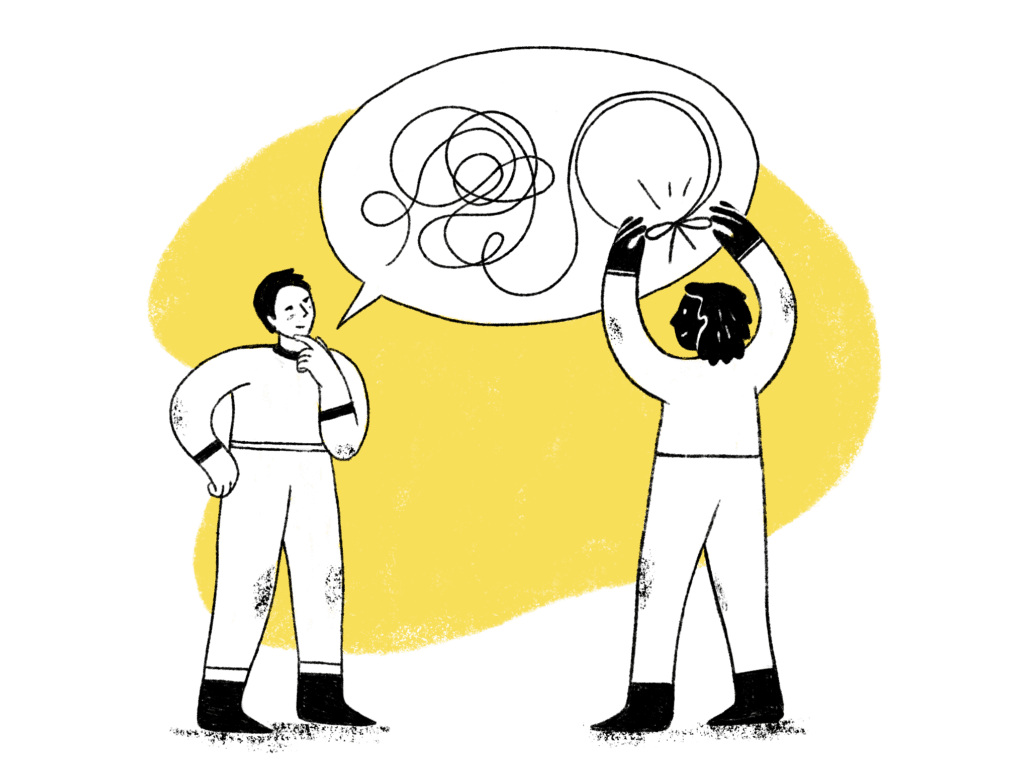
15 December 2025
6 min.
Communication au travail
18 February 2025
8 min.

Providing constructive feedback to an employee or colleague is often seen as a delicate—even uncomfortable—conversation. Yet, knowing how to give feedback without alienating someone is a valuable skill. When done well, these discussions become powerful tools for reinforcing psychological safety within the team. By offering constructive adjustments and taking time to check in, you create an environment where everyone understands expectations and can grow with confidence.
On the flip side, delivering feedback clumsily can create confusion, damage trust, and harm team dynamics. Vague comments and unspoken concerns often lead to misunderstandings and unnecessary tension. And let’s be honest—no one likes playing detective to figure out what they did wrong.
In this article, we’ll walk through key steps for giving effective feedback without causing friction. Along the way, you’ll learn how to apply best practices to turn these conversations into opportunities for mutual growth and continuous improvement. Because, let’s face it, regularly checking in helps prevent misunderstandings and keeps collaboration running smoothly.
Before jumping into the conversation, take a moment to get clear on why you’re giving this feedback. Is it about recurring delays with deliverables, behaviour that’s affecting team dynamics, or maybe a misstep when it comes to shared values? For instance, a colleague who often interrupts during meetings might unintentionally hold others back from contributing and limit the quality of the discussion.
Connect the situation to real, concrete impacts:
→ “I’ve noticed a few recent deliverables were late, which slowed down progress on some projects.”
→ “During meetings, I’ve seen some people hesitate to speak up—probably because conversations get interrupted pretty often.”
From the get-go, make sure your intent is clear and positive: “My goal here is for us to figure out together how we can avoid this from happening again.”
When you stick to facts instead of opinions, you create a space for open collaboration and a productive conversation.
Discover how to turn everyday challenges into opportunities for collaboration and success!

Giving feedback to a colleague can be tricky, but how you approach the conversation plays a key role in its success. To avoid tension and encourage a constructive dialogue, it’s essential to come from a place of empathy rather than sympathy.
→ Empathy means recognizing the other person’s emotions and understanding how they feel—even if you’d react differently in the same situation. It helps you approach the feedback with respect and without judgment.
→ Sympathy, on the other hand, involves sharing the other person’s emotions, which can sometimes blur the conversation by shifting the focus to comfort rather than problem-solving.
Active listening and non-violent communication are your best allies in creating an environment where your colleague feels heard and supported.
✘ “You’re always late.”
✔ “I’ve noticed you were late three times last week. That’s probably been challenging for you. How can we find a solution together?”
✘ “You never pay attention to details.”
✔ “I’ve noticed some recurring mistakes in the recent reports. Is there something in particular that’s causing you trouble?”
This approach helps keep the conversation supportive and collaborative, focusing on finding solutions rather than placing blame.
Make it clear that your goal is to work together to improve the situation:
“My goal is for us to find solutions together to make our meetings smoother and more inclusive.”
This approach encourages your colleague to take ownership and actively contribute to finding solutions. According to Psychology Today, collaboration and open communication are fundamental to healthy relationships and mutual satisfaction. (1)
Learn how to tackle tough conversations and get great results!

To give feedback without putting someone on the defensive, it’s essential to stay factual and specific. Concrete examples help illustrate the situation clearly, leaving no room for misinterpretation.
→ “In the last two meetings, you arrived 15 minutes late, and the team had to go over some points again.”
→ “I noticed that the weekly report contained several errors, particularly with the sales figures from the past two weeks.”
Link this step to best practices for handling tough conversations: approach the situation with clarity, avoid generalizations like “always” or “never”, and stay judgment-free. This helps maintain a climate of psychological safety where mistakes are seen as learning opportunities rather than sources of blame.
A study published in Harvard Business Review found that employees feel more engaged and receptive when they receive respectful feedback based on concrete observations rather than broad statements. (2)
Discover the key to happy, high-performing teams with psychological safety!

Giving feedback isn’t a monologue—make sure to leave space for your colleague to share their perspective.
Practice active listening:
✔ Rephrase: “If I understand correctly, you’re feeling overwhelmed by other priorities?”
✔ Ask open-ended questions: “What do you think might be contributing to these challenges?”
Problematic behaviours sometimes stem from underlying issues like workload overload, unclear expectations, or personal challenges.
This genuine listening shows that your goal isn’t to place blame but to understand and move forward together. By digging into the root causes, you’ll uncover practical ways to address the situation.
According to research from the Center for Creative Leadership, employees who feel understood by their managers are more likely to collaborate and engage in continuous improvement efforts. (3)
Learn to support the development of others!

An effective feedback conversation should end with a co-created action plan. This approach boosts engagement and ownership of the solutions.
Make suggestions and invite collaboration:
→ “How about we block some time together to help you stay on track with your deliverables?”
→ “Would it be helpful to revisit how we share speaking time during meetings?”
Make sure the solutions are specific, measurable, and realistic: “Starting next week, we can schedule a weekly check-in to review the reports.”
By acknowledging progress and offering constructive feedback along the way, you reinforce learning and build confidence.
Navigate discomfort and master the art of feedback!

Follow-up is a key step that often gets overlooked. Plan regular check-ins to track progress and make adjustments if needed:
✔ “Let’s check in two weeks from now to see how things are going.”
✔ “Would you like us to go over the process together to avoid these kinds of mistakes?”
Don’t forget to recognize the effort: “I’ve noticed you’ve been on time for meetings—thank you for making that improvement!”
Follow-up isn’t just about fixing issues; it’s about celebrating progress. It reinforces that the goal of the feedback conversation is to grow and improve together, not to assign blame.
Giving constructive feedback means acting with clarity, care, and commitment. By following these steps—clarifying the objective, taking a supportive stance, presenting the facts, listening actively, co-creating solutions, and following up—you can turn a tough conversation into a valuable growth opportunity for everyone involved.
Remember: good feedback is part of a bigger picture of inclusive leadership and psychological safety. And if you ever feel unsure about starting the conversation, just keep in mind that what’s left unsaid is often heavier than an honest, open discussion.
Working better together, adapting more easily, communicating more effectively… Soft skills are at the heart of collective success. But let’s be honest—it takes the right kind of learning approach to make people want to apply these skills every day. That’s exactly what we offer at Boostalab.
Because learning isn’t just about listening to lectures or reading abstract theories. It’s about experimenting, practicing, adjusting… and most importantly, taking action.
✔ Le Lab: Our online learning platform is designed to make learning engaging and flexible. Interactive courses available anytime, anywhere.
✔ Interactive team training paths: Immersive learning experiences that span several weeks, combining workshops with hands-on practice.
✔ Training boosts: A fun, interactive group workshop that helps build and reinforce key behaviours in just 30 days.
✔ Ready-to-train kits: Practical, engaging content that’s easy to implement directly in your LMS.
Not sure which soft skills training is right for you? Take the quiz and find the perfect fit!
1. Strauss Cohen, I. (2024, September). The foundation of healthy relationships. Psychology Today.
2. Porath, C. (2016). Give Your Team More-Effective Positive Feedback. Harvard Business Review.
3. Center for Creative Leadership. (2020). Executive Outlook 2020: CCL’s summary of leadership development research. CCL.
Blog

15 December 2025
6 min.

21 November 2025
8 min.

14 November 2025
7 min.